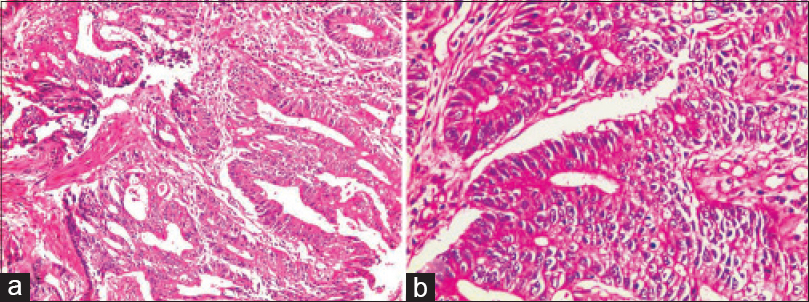Translate this page into:
Anal canal adenocarcinoma in a patient with psoriasis treated with etanercept
Correspondence Address:
Min Zheng
Department of Dermatology, Second Affi liated Hospital, Zhejiang University School of Medicine, Hangzhou - 310 009, Zhejiang Province
China
| How to cite this article: Yang BB, Man XY, Zheng M. Anal canal adenocarcinoma in a patient with psoriasis treated with etanercept. Indian J Dermatol Venereol Leprol 2016;82:103-104 |
Sir,
Psoriasis is a chronic inflammatory disease that can affect the skin and joints. The treatment of psoriasis varies depending on disease severity and includes topical and systemic therapies. Among the latter are biological agents that target cellular immunity. The success of biological treatments in patients with psoriasis has generated much enthusiasm within the dermatology community. However, biological treatments may be associated with an increased risk of malignancy because of their immunosuppressive properties. Various case reports have linked them to the development of malignancies such as skin cancers and lymphoma.[1] We report a case of anal canal adenocarcinoma that developed after 10 months of twice weekly etanercept for psoriasis.
A 58-year-old man was diagnosed with psoriasis 3 years ago. The patient underwent a number of systemic treatments and had not taken any other medication except etanercept for about 10 months before the onset of anal symptoms. He had started treatment with etanercept, 25 mg twice weekly subcutaneously about 1 year previously and had tolerated etanercept well. However, 10 months after the initiation of etanercept, he presented with anal bleeding and perianal pain. The patient had no history of prior chronic perianal disease and no relevant family history of colorectal carcinomas.
Serologic examination for human papillomavirus, HIV, syphilis, hepatitis, carcinoembryonic antigen, CA19-9 and alpha-fetoprotein was negative. The examination of the anus and rectum revealed an irregular 1 cm ulcerated lesion located 1 cm proximal to the anal margin. Biopsies confirmed that the lesion was a moderately differentiated adenocarcinoma [Figure - 1] a and b]. Colonoscopic assessment of the remaining colon was normal. The patient underwent abdomino-perineal resection and postoperative radiochemotherapy and the postoperative histopathology confirmed excision of a T2N1M0 adenocarcinoma of the anal canal.
 |
| Figure 1: (a and b) Microscopic findings of anal canal adenocarcinoma. The tumor is invasive and moderately differentiated. (a) (H and E, ×100). (b) (H and E, ×400) |
Etanercept, like infliximab and adalimumab is a tumor necrosis factor-α (TNF-α) antagonist. Tumor necrosis factor-α receptor blockers are a significant advance in the treatment of psoriasis and psoriatic arthritis. The immune regulation of tumor necrosis factor-α has been highly controversial concerning its contribution to carcinogenesis.[2] Tumor necrosis factor-α plays a complex role in the development and progression of tumors.[3]
Adenocarcinoma of the anal canal is rare, accounting for only 3–9% of all anal canal neoplasms.[4] It is aggressive with a high rate of distant metastasis and few useful immunohistochemical markers of this carcinoma are known to date. Previous reports indicate that the risk factors for the development of anal canal adenocarcinoma include smoking, chronic anorectal disease, HIV infection, human papillomavirus infection and homosexuality.[5],[6] Our patient had none of these risk factors. Egea-Valenzuela et al. have also previously reported a case of adenocarcinoma of the rectum and anus associated with a biologic drug, infliximab.[7]
Financial support and sponsorship
Nil.
Conflicts of interest
There are no conflicts of interest.
| 1. |
Esser AC, Abril A, Fayne S, Doyle JA. Acute development of multiple keratoacanthomas and squamous cell carcinomas after treatment with infliximab. J Am Acad Dermatol 2004;50 5 Suppl: S75-7.
[Google Scholar]
|
| 2. |
Jin H, Cho HH, Kim WJ, Mun JH, Song M, Kim HS, et al. Primary thyroid marginal zone B-cell lymphoma in a patient with psoriatic arthritis treated with etanercept. J Am Acad Dermatol 2014;71:e152-3.
[Google Scholar]
|
| 3. |
Knight B, Yeoh GC, Husk KL, Ly T, Abraham LJ, Yu C, et al. Impaired preneoplastic changes and liver tumor formation in tumor necrosis factor receptor type 1 knockout mice. J Exp Med 2000;192:1809-18.
[Google Scholar]
|
| 4. |
Salati SA, Al Kadi A. Anal cancer - A review. Int J Health Sci (Qassim) 2012;6:206-30.
[Google Scholar]
|
| 5. |
Chang GJ, Gonzalez RJ, Skibber JM, Eng C, Das P, Rodriguez-Bigas MA. A twenty-year experience with adenocarcinoma of the anal canal. Dis Colon Rectum 2009;52:1375-80.
[Google Scholar]
|
| 6. |
Leonard D, Beddy D, Dozois EJ. Neoplasms of anal canal and perianal skin. Clin Colon Rectal Surg 2011;24:54-63.
[Google Scholar]
|
| 7. |
Egea-Valenzuela J, Belchí-Segura E, Essouri N, Sánchez-Torres A, Carballo-Alvarez F. Adenocarcinoma of the rectum and anus in a patient with Crohn's disease treated with infliximab. Rev Esp Enferm Dig 2010;102:501-4.
[Google Scholar]
|
Fulltext Views
3,421
PDF downloads
2,473





